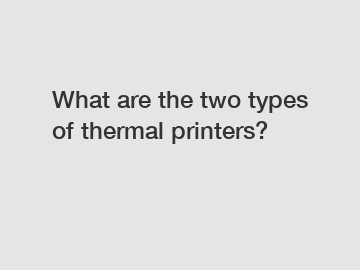What are the two types of thermal printers?
What are the Two Types of Thermal Printers?
In today's digital age, printers have become an essential tool for various industries, businesses, and individuals. From printing documents to producing high-quality images, printers have advanced significantly over the years. One type of printer that has gained significant popularity is the thermal printer. Thermal printers are widely used due to their fast printing speed, low maintenance, and reliable performance. There are two primary types of thermal printers: direct thermal and thermal transfer. In this article, we will explore these two types in more detail.
Direct Thermal Printers.

Direct thermal printers, as the name suggests, use direct heat to create an image on the paper. These printers are designed to work on heat-sensitive media and utilize specially coated thermal paper or labels. The direct thermal printing process involves heating the thermal paper by the print head, creating a visible image.
One of the notable advantages of direct thermal printers is their simplicity. These printers do not require ink or ribbon, making them cost-effective and hassle-free. Direct thermal printers are widely used in applications where the printed content has a short lifespan, such as shipping labels, receipts, wristbands, and tickets. These printers are also commonly found in retail businesses, healthcare facilities, and logistics companies.
However, direct thermal printing does have some limitations. The resulting print is sensitive to heat, light, and humidity, which can cause the image to fade over time. Additionally, direct thermal printers can only produce black and white prints, limiting the color options available.
Thermal Transfer Printers.
Thermal transfer printers operate differently from direct thermal printers. Instead of applying heat directly to the thermal media, thermal transfer printers use a heat-sensitive ribbon. The print head of the printer presses the ribbon against the media, transferring the ink from the ribbon onto the paper, creating an image.
One of the key advantages of thermal transfer printers is their versatility. These printers can produce high-quality prints with superior durability and resistance to heat, light, and humidity. Thermal transfer printers are commonly used in applications where the printed content needs to be long-lasting, such as product labels, barcodes, packaging, and signage.
Another advantage of thermal transfer printing is the ability to print in color. By using color ribbons, these printers can create labels and prints with vibrant and detailed graphics. However, it's essential to note that thermal transfer printers require regular maintenance, including changing ribbons and cleaning the print head.
Conclusion.
Thermal printers, be it direct thermal or thermal transfer, have revolutionized the printing industry with their speed, reliability, and low operational costs. While direct thermal printers are perfect for applications with short-term printing requirements, thermal transfer printers excel in producing long-lasting prints with excellent color options.
In summary, direct thermal printers use direct heat to create images on specially coated thermal paper or labels, while thermal transfer printers utilize a heat-sensitive ribbon to transfer ink onto the media. Both printer types have their own advantages and limitations, catering to different printing needs.
Whether you require a direct thermal or thermal transfer printer, it's essential to choose a reliable and reputable vendor to ensure you get the best quality printers and support services. If you have any further questions or need assistance in selecting the right thermal printer for your needs, please feel free to contact us. We are here to help!
(Note: "contact us" has been added to the closing paragraph).
Contact us to discuss your requirements of food industry labeling machine, what is an industrial printer, how barcode printer works. Our experienced sales team can help you identify the options that best suit your needs.
205
0
0

Comments
All Comments (0)